21 Kids Activities to Encourage Speech Development
Sep 13, 2024 From day one, your baby is listening to you intently to eventually communicate with you. Those listening skills will then turn into eye contact, cries, smiling, giggling, babbling, and more. In fact, your baby’s first communication begins with crying.
Have you ever noticed your baby cries differently for different needs? Different cries are baby’s way of communicating with you!
But how do a baby’s cries develop into speech? By the age of one, your baby will develop both nonverbal and verbal language skills to communicate. To help your baby develop essential language milestones, here are 21 kids’ speech activities to foster listening skills and speech development for your baby!
One-Year-Old Speech and Language Milestones
During year one, most babies develop the following language milestones:
- Recognizes familiar voices
- Responds to familiar voices by smiling and laughing
- Coos, squeals, shouts
- Has different cries for different needs
- Communicates through gestures (points to a bottle to tell you he/she needs more milk)
- Repeats sound or actions/gestures
- Responds to simple instructions (“Come here please”)
- Repeats words
- Recognizes the names of common objects
- Shows interest in reading books
Take this free cutting-edge 3-minute quiz. You will find out if your child is on track with his milestones and receive a free report with a personalized plan of learning. Speech Blubs is full of activities to encourage speech development!
21 Kids Activities for Speech and Language Development
1. Animal Jam
Simply say phrases like:
- A cow goes ‘moo’
- A duck says ‘quake’
- A chicken goes ‘cluck’
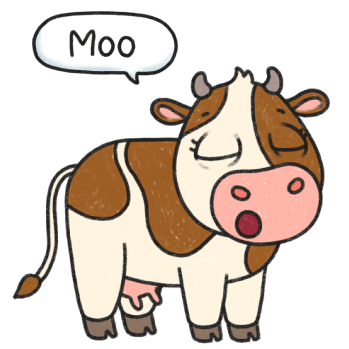
This helps your baby recognize the names of common animals along with their unique sounds. The best part about Animal Jam is it can be done anywhere, even in the car!
2. Sound Stories
Storytime is a wonderful time to bond with your baby. But it is also a way to enrich your baby’s language development. To learn speech skills, your baby also needs to learn nonverbal communication and sounds in response to everyday things. Instead of reading through a book, make reading fun by adding facial expressions, voice inflections, sound effects, and animal sounds.
3. Talk Back
Babies communicate by crying, cooing, and squealing to get your attention. When he/she is communicating with you, start talking back. If your baby coos, coo back. If baby smiles at you from across the room, smile back while saying ‘Hello’ and waving.
Babies learn through imitation. Over time your baby will not only smile, but say ‘Hello’ back to you while waving.
4. Name That Color
Everything is made of color. To help foster early color recognition, say the colors of everything you see.
For example: Name the colors of cars passing by while taking a walk to the park; tell your baby what color clothes he/she is wearing, toy colors, and more!
5. Karaoke
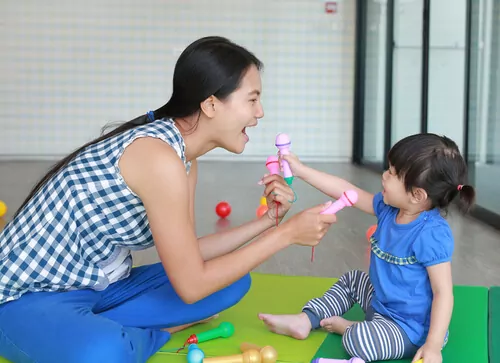
Whether you can keep a tune or not, your baby doesn’t care! Singing is a perfect way to provide a language learning opportunity that includes voice inflections, new words, and facial expressions. So go ahead and make a silly face while singing at the top of your lungs!
6. Monkey See, Monkey Do
“Monkey see, monkey do” is all about facial expressions. Facial expressions are an important aspect of speech development because they convey emotions. Research suggests that nonverbal forms of communication like facial expressions make up 60 to 65% of communication.
To encourage increased emotions through facial expressions, hold your baby in front of you and mimic his/her facial expressions. When your baby smiles, smile back. Better yet! Stick out your tongue, make a silly face, and watch to see if baby repeats your expressions.
7. Mirror, Mirror
Since tummy time is an essential part of a baby’s physical development, take advantage of tummy time by using a mirror. Not only will baby enjoy his/her reflection, but each time a coo or giggle is made your baby can see where the sound is coming from and his/her facial expressions when ‘speaking.’
8. Bicycle
After a diaper change or anytime your baby is on his/her back, take baby’s legs in move them in bicycle motions while singing a silly song or reciting a nursery rhyme. The bicycling motion will allow baby to focus on your face while you sing or speak to her/him.
9. Face-To-Face
Face-to-face is one of my favorite fun activities for promoting speech development! Lay on the floor with your little one and face each other. Point to areas of her/his face while naming the parts of the face. This will help your baby not only learn hand/eye coordination, but early recognition of parts of the face.
Better yet, take this activity one step further by doing the following example:
- Point to baby’s nose and say ‘nose’
- Take baby’s hand and touch your nose while saying ‘nose’
Having baby touch your nose allows her/him to understand that everyone has similar body parts with the same names.
10. Repeat after Me
This simple game works best when facing your baby. Start making babbling sounds AKA baby talk (especially with vowel sounds) and wait for your baby to repeat them back to you. Some common coos and babbling sounds include: Oohh/aww; mamma/dada.
This type of speech normally does not develop until four months of age. So don’t be upset if your one-month-old is not catching on, just give it time. Before long you and baby will be chattering back-and-forth.
11. Say My Name
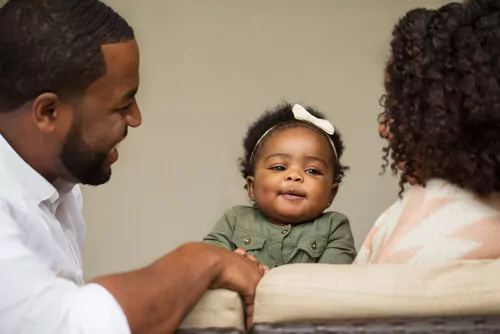
One of the biggest language developments a baby will make is learning/recognizing his/her name! While it’s different for every baby, most babies will recognize and respond to their names between 3 to 6 months of age.
To help baby along with this language development, say your baby’s name whenever possible. Some fun ways to say your baby’s name include:
- Adding his/her name to a silly song,
- Asking a question with his/her name,
- Replacing the names of book characters with your baby’s name.
12. Echo
To develop language babies need to repeat or ‘echo’ words. A great way to include new words and increase language skills is by adding expressive phrases to everyday situations.
For instance, if your baby drops his/her bottle on the floor say, “Oh no!”
I’ve found this activity also helps develop speech by adding sound effects to baby’s activities. Each time your baby jumps while holding him/her, add a sound effect like “boing, boing.” While trying to calm your crying baby, rock him/her back and forth while saying, “swoosh, swoosh.”
Over time, baby will begin to “echo” what he/she hears.
I know it seems silly, and that’s because it is! Echo is meant to be a fun learning activity for babies, so the sillier you get with sound effects and funny phrases the more baby absorbs new words, sounds, and phrases.
13. This Little Piggie
Next time, your baby is laying on his/her back, grab a foot and start saying the rhyme “This Little Piggie.” Since this game doesn’t number each of the five toes, the rhyme needs to be modified to help baby learn numbers.
Instead of saying “This little piggie went to the market” say, “The first little piggie went to the market; the second little piggie stayed home,” etc.
Another I’ve done the rhyme to help with number recognition is by saying the rhyme the following way:
- “One little piggie went to the market”
- “Two little piggies stayed home”
- “Three little piggies had roast beef”
- “Four little piggies had none”
- “And five little piggies cried wee, wee, wee all the way home”
While this may give the rhyme much more little piggies, it still allows your baby to hear each number and count the number with each toe.
14. Carpool
Carpool is an activity that’s perfect for crawling babies! While baby is crawling, get down and your hands and knees and teach baby how to push a car or truck as she/he is crawling. Your baby doesn’t have to keep a constant hand on the car, just a little push in between crawling motions.
To include speech development, add car sound effects; tell a funny story about the car ride; sing “Wheels on the Bus/Car/Truck”; etc.
15. Roll-A-Ball

This game if perfect for babies who can sit unsupported and have decent hand/eye coordination. Simply take a (medium- to large-sized) ball and roll the ball directly toward him/her. Incorporate language skills by saying phrases like “Here is your red ball!”
Roll-A-Ball can become more advanced by helping baby understand simple instructions and responding to those instructions. Try rolling a ball over to him/her and asking him/her to roll the ball back.
16. Count with Me
You can help your baby with learning numbers by counting out loud to him/her every day. This activity doesn’t require extra effort on your part, simply start talking and counting out loud.
The following are great ways to include number counting each day:
- Count each stair step as you carry baby upstairs,
- Count how many bananas you bought at the store,
- Count baby’s fingers and toes.
17. Disappear, Reappear
Instead of playing a regular game of peek-a-boo, try playing with your baby’s favorite toy or stuffed animal. Hide his/her toy from view. Wait and few seconds and say “peek-a-boo.” You can also incorporate more speaking skills into the game by adding some creative dialogue!
Examples: “Peek-a-boo! There you are . . . Mister Bear missed you so much! Thank goodness you found him!”
18. Finger Puppets
Small finger or hand puppets are an amazing way to help develop language skills for your little one! By using finger or hand puppets to tell a story you are showing baby the following language and speech skills:
- Different facial expressions to show emotions when speaking
- Creative dialogue between two or more puppets (similar to speaking between two people).
19. Fruits and Veggies
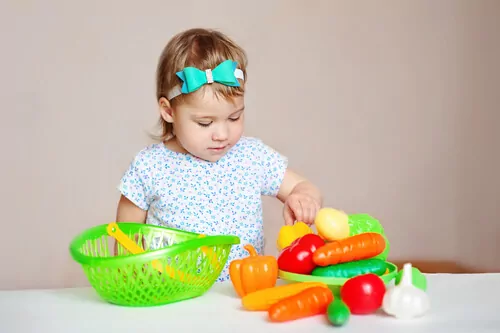
Much of a baby’s speech development has to do with repetitive hearing and use of everyday words. One way to help with word recognition of common fruits and vegetables is by playing pretend with plastic fruits and vegetables.
Although baby will need to be supervised with pretend plastic food because of small pieces, he/she will learn how to recognize a banana, carrot, pear, and more!
Also, don’t forget to count your fruits and veggies for number recognition!
20. Picture This
One of the easiest ways to help develop language skills in babies is through flashcards. Flashcards with pictures and writing help your baby begin to recognize what the picture or action is on the card along with the corresponding word or phrase.
While your baby won’t say the words out loud for a while, it helps him/her to recognize the picture with the associated word.
21. Build a Tower
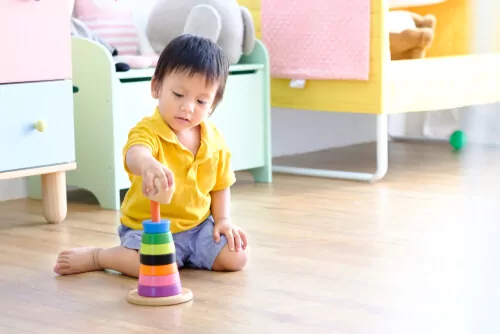
Building a tower with blocks is perfect for developing hand/eye coordination. But this activity can also be used for encouraging language development in babies.
As you watch or directly help your child stack blocks, say the color of the block along with counting the blocks as the tower is being stacked. Many available baby blocks also have pictures in which you can describe the picture to your baby. For instance: If you have blocks with animals pictured on them, name each animal along with the sound the animal makes.
It’s a Process
Speech development is more than speaking words. It is a complex system of verbal and nonverbal communication. To express emotions and thoughts you baby will first begin to cry to communicate his or her needs to you.
After communication crying, the sky is the limit for speech development and your baby!
But your baby needs your help along the way! The best way to develop language skills by year one is through imagination and play.
Each of the 21 activities above combines:
- Imaginative play,
- Simple instructions for you and baby to follow,
- Activities involving both verbal and nonverbal speech.
So start playing some of these fun speech and language activities to give your baby a head start before he or she turns one!
Read more on how to utilize kids activities to reach developmental milestones! If your toddler already reached their wonderful twos, consider using Speech Blubs App in combination with offline games for kids to build their vocabulary.


